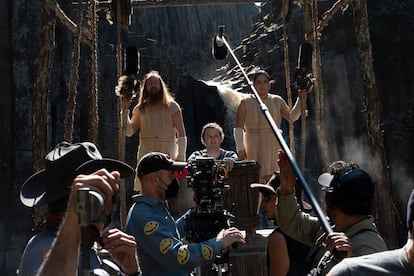The other ‘nearshoring’: film and TV production stands out in Mexico
More than $5 billion flowed into Mexico as foreign direct investment in 2022 in the film and video industry alone

It’s not just Tesla. As American companies move their manufacturing operations from China to Mexico, the country is also experiencing another type of nearshoring: that of the audiovisual industry. High inflation in the United States, geographic proximity, and award-winning Mexican talent have aligned in recent years to make Mexico an attractive destination for film and television production.
Foreign direct investment flows into the film and video industry went from $23 million in 2020 to $5.3 billion last year, according to official data. In Mexico City alone, from 2020 to 2021, direct investment – both domestic and foreign – jumped 49%, according to data from the Government Film Commission (CFilma). The total in 2021 was $563 million.
In the last two years, ten commercials produced for the most important day of advertising in the US, the Super Bowl, have been made in Mexico, said Avelino Rodríguez, CEO of the country’s largest audiovisual production house, The Lift, and president of the National Chamber of the Cinematographic Industry (Canacine). This year alone there were five, he added, “and there should have been six, because that territory has been conquered.”
His optimism is contagious. “I am excited because our generation is working hard because we understand that building the economy is as important as doing culture,” says Rodríguez. A few days before meeting EL PAÍS at his office in the San Miguel Chapultepec neighborhood, in Mexico City, Rodríguez met with the Secretary of Labor in an attempt to draw the attention of the authorities to what he considers to be a huge potential for Mexico, if this moment is seized.
It started in 2020, when the US imposed restrictions due to the covid-19 pandemic. By comparison, Mexico was far more lax and in the capital, for example, businesses practically did not close. This attracted the US industry, which discovered other competitive advantages. Among them is the climate in the center of the country, which does not change much during the year, making filming easier.
More reasons were piling up to produce in Mexico. The salary of a technical worker in the US is between three and four times higher (in the case of post-producers, the difference is 10 to one), creating a very large economic incentive. In addition, the labor market in the US continues to tighten. In October 2021, crew workers in Hollywood went on strike, demanding better wages and benefits. Under these conditions, the geographical proximity and “world-class Mexican talent” make Mexico a very attractive destination, explains Rodríguez.
That film directors like Alejandro G. Iñárritu, Alfonso Cuarón and Guillermo del Toro have won Oscars generates momentum for the industry throughout the country, explains Rodríguez. “For example, we have top-level costume designers. One of the Super Bowl commercials was made by a Mexican costume designer who is competing with the best in the world and with many Oscar winners. We’ve had art directors, Oscar winners, who come up to us and say ‘why is she my assistant? She’s better than me!’”

In the most recent final selection of the annual award granted by the US Association of Independent Commercial Producers (AICP), 15% of the work was done in Mexico and four commercials won, which grants them a place in the permanent collection of the Museum of Modern Art in New York (MoMa). In this industry, every recognition counts, especially when competing with countries like Spain, Portugal, Iceland, Canada, Uruguay and Chile, which are also well positioned and offer incentives.
This industry also has an economic spillover effect in the tourism sector. Although the production team is local, US companies that commission the projects travel to Mexico to supervise. “We were the lifeline of premium tourism during the pandemic,” says Rodríguez, about his company, The Lift. “Last year we spent 8,500 nights at the Four Seasons [hotel]. We were by far the biggest customer. Bigger than JPMorgan, than Ford, bigger than the [Formula 1] Grand Prix in those types of hotels, because every time we produce a project, there is supervision by those who commission us to do the work.”
Next Tuesday, Mexico City mayor Claudia Sheinbaum will meet with executives of the Motion Picture Association of America (MPA) and Amazon Prime, the streaming platform, at the presentation of CFilma’s statistical yearbook. “The opportunity to have very solid indicators can give the industry a good platform and take advantage of the situation that there is also nearshoring”, assures Rodríguez.
“The possibilities that exist at this moment when the American market continues to become more expensive and the Mexican market is gaining so much creative footprint” are enormous, Rodríguez says. “I think it is a moment where there is a generational bonus in the Mexican talent that is positioning itself.”
Sign up for our weekly newsletter to get more English-language news coverage from EL PAÍS USA Edition
Tu suscripción se está usando en otro dispositivo
¿Quieres añadir otro usuario a tu suscripción?
Si continúas leyendo en este dispositivo, no se podrá leer en el otro.
FlechaTu suscripción se está usando en otro dispositivo y solo puedes acceder a EL PAÍS desde un dispositivo a la vez.
Si quieres compartir tu cuenta, cambia tu suscripción a la modalidad Premium, así podrás añadir otro usuario. Cada uno accederá con su propia cuenta de email, lo que os permitirá personalizar vuestra experiencia en EL PAÍS.
¿Tienes una suscripción de empresa? Accede aquí para contratar más cuentas.
En el caso de no saber quién está usando tu cuenta, te recomendamos cambiar tu contraseña aquí.
Si decides continuar compartiendo tu cuenta, este mensaje se mostrará en tu dispositivo y en el de la otra persona que está usando tu cuenta de forma indefinida, afectando a tu experiencia de lectura. Puedes consultar aquí los términos y condiciones de la suscripción digital.
More information
Archived In
Últimas noticias
Welcome to the post-religion era: The idea of Christianity as the absolute truth has become obsolete
‘I thought you would like it’: The risky sexual practice popularized by TV shows and TikTok
The digitalization of tourism: ‘They promise experiences and gave us the worst possible one’
Mexican peso defies uncertainty with forecasts of a new period of stability in 2026
Most viewed
- Sinaloa Cartel war is taking its toll on Los Chapitos
- Reinhard Genzel, Nobel laureate in physics: ‘One-minute videos will never give you the truth’
- Oona Chaplin: ‘I told James Cameron that I was living in a treehouse and starting a permaculture project with a friend’
- Why the price of coffee has skyrocketed: from Brazilian plantations to specialty coffee houses
- Silver prices are going crazy: This is what’s fueling the rally












































